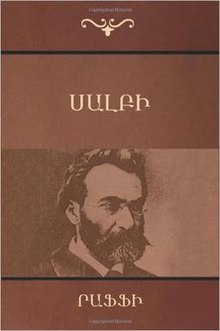You can help expand this article with text translated from the corresponding article in Armenian. (January 2016) Click [show] for important translation instructions.
|
Salbi (Սալբի Salpy) is an Armenian language novel by the novelist Raffi. Although his earliest novel, written 1855-1874, it was not published until 1911.[1][2]
 | |
| Author | Raffi |
|---|---|
| Original title | (Սալբի Salpy) |
| Language | Armenian |
| Genre | Novel |
Publication date | 1874 |
| Publication place | Armenia |
| Media type | |
General Description
editThe ideological essence of the novel "Salbi" is the issue of national liberation. According to the author, Rustam, the novel's hero, who rebels against the dictatorship, is the birth of free nature and unfair human life. Rustam and Salbu, the image of a leading Armenian woman, are opposed by the Armenian clergy, merchants, and the humble servants of the Persian khans, ter-Maruk, ter-Markos, Solomon-bek Avazakyants, and others. All these are allied with the Persian feudal-barbarian power by their class nature and enjoy its patronage.
The novel "Salbi" is a romantic work. In it, the characters are built with the absolute contrast of positive and negative, internal and external features. The plot situations of the novel are also romantic; they are exceptional, supernatural, and shrouded in mythical mystery. Actions in the novel are dynamic. The author's imagination has given birth to lively scenes, which are given with lavish descriptions.
References
edit- ^ The Booklist and Subscription Books Bulletin - Volume 55 1958 -- Page 239 "Raffi. Samuel, badmagan veb. 1926. 764p. Vienna, Mkhitaryan Dbaran, $2.50. A historical novel by the most popular writer of the nineteenth century.... Khachakoghi hishadagarane, Khamsayi melikutiunnere, Khente, Mine aysbes, miuse aynbes, Salpi, and Touif Pete — are recommended without reservation."
- ^ The Heritage of Armenian Literature: From the eighteenth ..Agop Jack Hacikyan, Gabriel Basmajian, Edward S. Franchuk - 2005 . -0814332218 Page 97 "Raffi's earliest novel, Salbi, was not published until 1911, although he began to write it in early 1855, even before the publication of Abovian's Verk Hayastani (1858)."